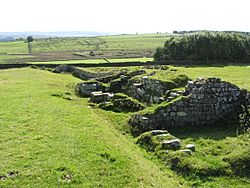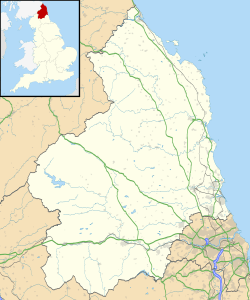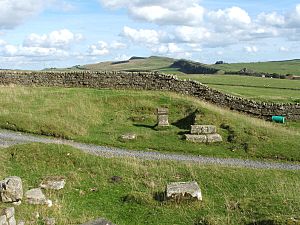Aesica facts for kids
Quick facts for kids Aesica |
|
|---|---|
| Northumberland, England, UK | |

Remains of Aesica Roman Fort (West Gate)
|
|
|
Location in Northumberland
|
|
| Coordinates | 54°59′42″N 2°27′50″W / 54.995°N 2.464°W |
Aesica (also known as Great Chesters today) was an important Roman fort. It was located about one and a half miles north of the town of Haltwhistle in Northumberland, England. This fort was the ninth one along Hadrian's Wall. It stood between Vercovicium (Housesteads) to the east and Magnis (Carvoran) to the west. Aesica's main job was to protect the Caw Gap, a place where the Haltwhistle Burn river crosses the Wall.
Contents
What Was Aesica Like?
Building the Fort
Historians believe the fort was finished in the year 128 AD. Unlike some other forts on Hadrian's Wall, Aesica was built entirely south of the Wall. The Wall itself was narrower at this spot. However, it stood next to foundations that were meant for a wider wall.
For a long time, people wondered why the wider foundations weren't used. In 1939, they found out that Milecastle 43 was already built there. A milecastle is a small fort built every Roman mile along the Wall. It seems this milecastle stopped the fort's north wall from being built on the original wide foundations. The milecastle was likely taken down after the fort was completed. Today, you can't see the fort's east gate or east wall.
Fort Size and Shape
The fort was shaped like a rectangle, measuring about 108 meters (355 feet) from north to south. It was about 128 meters (419 feet) from east to west. This made it a relatively small fort, covering about 1.2 hectares (3 acres). Part of the fort's north-east corner is now covered by farm buildings. These buildings were built right over where the Wall used to be.
Gates and Towers
Aesica had three main gates: one to the south, one to the east, and one to the west. Each gate had two openings and tall towers. At some point, the west gate was completely blocked off. There were also towers at each corner of the fort.
The Military Way was a road that ran behind Hadrian's Wall. It entered Aesica through the east gate and left through the west gate. Another road, called the Stanegate, connected to the fort through its south gate.
Surroundings of the Fort
The Vallum was a large ditch and earthwork built by the Romans. It ran a short distance south of the fort. A road from the south gate crossed the Vallum to connect with the Stanegate.
Outside the fort, to the south and east, was a vicus. This was a small civilian settlement where families of soldiers and traders lived. Several old tombstones have been found in this area.
The fort got its water from an aqueduct. An aqueduct is like a long channel or bridge that carries water. This one was about 10 kilometers (6 miles) long. It brought water from the top of the Haltwhistle Burn, north of the Wall.
Who Lived at the Fort?
A garrison is a group of soldiers stationed at a fort. In the 2nd century, the soldiers at Aesica were from the Sixth Cohort of Nervians. After them, the Sixth Cohort of Raetians took over. In the 3rd century, the Second Cohort of Asturians lived there. They were joined by a group called the Raeti Gaeseti.
Digging Up the Past
Discoveries in 1894
People started doing excavations (careful digging to find old things) at Aesica in 1894. During these digs, they cleared the old walls of the fort. Inside the west tower of the south gate, they found a hidden collection of jewelry! This included:
- An enamel brooch shaped like a hare
- A beautiful gilded bronze brooch, which is a masterpiece of Celtic art
- A silver necklace with a pendant
- A gold ring
- A bronze ring with a special Gnostic gem
During this same excavation, they partly uncovered the fort's main headquarters building, called the principia. It even had a strong, vaulted underground room for valuables. A barrack block, where soldiers slept, was also found to the south-west of the headquarters.
The Bathhouse
In 1897, an ancient Roman bathhouse was discovered. It was about 90 meters (100 yards) south of the fort, east of the road to the Stanegate. Roman bathhouses were like ancient spas! This one had several rooms for different parts of the bathing process:
- A dressing room
- A latrine (toilet)
- A cold room with a cold bath
- A dry-heat room (like a sauna)
- A warm, steamy room
- A hot, steamy room



